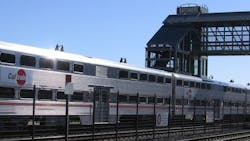Getting state rail plans back on track: Gaps and best practices
Mineta Transportation Institute’s (MTI) latest research, “A Model for Integrating Rail Services with Other Transportation Modalities: Identifying the Best Practices and the Gaps for California’s Next State Rail Plan,” looks at best practices and gaps that can inform California and other states in their future rail service plan development.
According to observations from the Federal Railroad Administration (FRA) staff, the California State Rail Plan (CSRP) is among the best rail plan documents published by any jurisdiction in the United States to date (and Illinois High-Speed Rail recently released a statement noting that Illinois aspires to produce a plan similar to the 2018 CA plan).
As such, MTI researchers used the CSRP as the basis of comparison to state rail service plans for all 50 states for this latest research.
The state plans examined in this research were those submitted to the FRA as of June 2020—and as required under Section 303 of the Passenger Rail Investment and Improvement Act (PRIIA) of 2008. The research steps included outlining the elements of FRA’s 2013 state rail plan guidance; identifying and reviewing other sources of rail plans, including state rail plans from Colorado, Michigan, North Carolina, Virginia and Washington State; summarizing, comparing and evaluating innovative practices of these plans; and preparing commentary and analysis identifying improvements that California and other states could make in preparing and submitting future rail service plans.
Based on the analysis of state rail plans, as well as academic discussion of state rail planning, the following recommendations are offered:
- Establish measurable performance standards.
- Enhance the resilience of rail infrastructure.
- Draw on parallels of rail to the interstate highway system.
- Innovate means of rail funding and financing.
- Create decision making frameworks with tools to improve future system performance.
- Establish state and regional rail advisory bodies.
- Perform periodic reviews of rail plan implementation.
- Conduct active outreach to the public and stakeholders.
- Support ongoing initiatives by Caltrans.
- Revise FRA guidance to promote more nationally cohesive rail planning.
“We found academic literature regarding optimal, state-level rail applications were consistent with the FRA’s state rail plan guidance. A review of each state rail plan from across the county reflected differing attitudes, realities and needs related to rail networks from state to state—identifying unique connections to their region, but also displaying lower levels of engagement in proficient rail planning,” said the study’s coauthor Dr. Wenbin Wei.
Most states share common goals—including improving the safety of their transportation systems. These goals also include the improvement of their transportation systems to stimulate, support and enhance the movement of goods to ensure a prosperous economy. Moving forward, interstate and international collaborations will prove critical to these aspirations.
Goals and plans will continue to evolve into the future, and though there is still a considerable amount of work to be done, research and implementation of plans can improve safety, efficiency and more when it comes to rail and all transportation.
The full report can be found here: https://transweb.sjsu.edu/sites/default/files/1949-Peterson-Best-Practices-California-State-Rail-Plan.pdf



